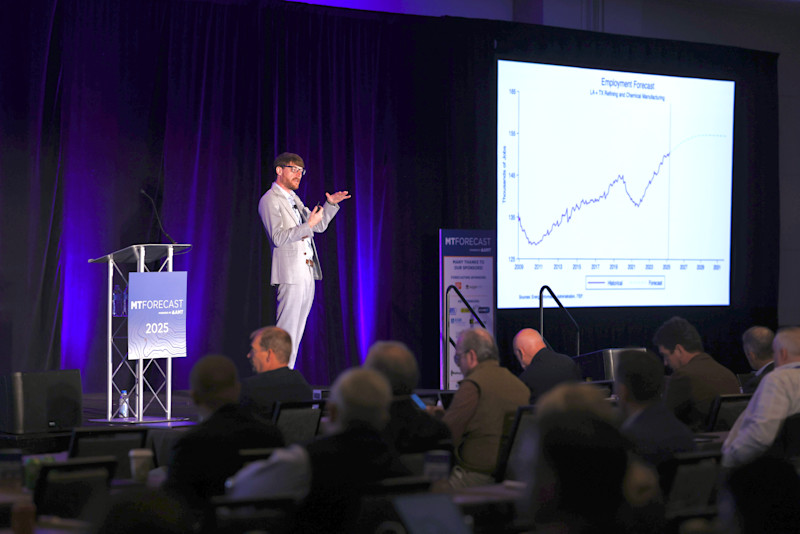MTForecast 2025, which took place October 15-17 in Schaumburg, Illinois, provided manufacturing leaders with insights into the coming market and policy trends their businesses are likely to face in the next 12-18 months. Beyond the macroeconomic and policy trends that are affecting all manufacturers, experts gave deep dives into specific manufacturing technology end-user markets and shared their outlook for these key customer industries. Highlights from the sector-by-sector breakdowns reveal a landscape of both opportunity and challenge.


Aerospace
Despite persistent supply chain constraints and labor shortages, aerospace remains a bright spot, although not yet at the pre-Covid peak. Airbus continues to lead in new orders, while Boeing shows signs of stabilization and growth. The sector is buoyed by strong commercial jet demand and long backlogs, increased global defense spending, and support for new platforms. Manufacturing technology companies should be sure to keep an eye out for any news related to a new Boeing model, which would lead to significant retooling and capital expenditures in future years as they bring the new platform online.


Automotive
The U.S. auto market is stabilizing, with light vehicle sales forecasted to increase slightly in 2026. The industry is not likely to see dramatic peaks in future years but rather a plateau shaped by affordability concerns, evolving lifestyles, and tariff uncertainty. The number of manufacturers in this sector continues to grow. Electrification continues to reshape the industry, although hybrids appear to be the driving force as opposed to full electrification. Chinese automakers are gaining traction and pressuring North American OEMs; with limited room for domestic growth, they must look abroad to sustain expansion.


Energy
The Gulf Coast is emerging as a hub for low-carbon manufacturing, driven by decarbonization mandates and rising electricity demand. Investments in electric vehicles, heat pumps, artificial intelligence, and data centers are fueling a new era of energy consumption. Electricity demand will increase but probably not as much as clickbait headlines suggest as the energy efficiency of new products is improving. U.S. energy exports are expected to grow, positioning the region as a global supplier of power and fuel. Renewables will likely continue to grow market share but perhaps more slowly than anticipated due to tax credit and policy changes.


Defense
U.S. defense spending remains robust, with the FY2026 budget exceeding $1 trillion. Spending levels are now approaching their post-World War II peak, seen at the end of George W. Bush administration. Priorities include missile defense (i.e. the Golden Dome), shipbuilding, and nuclear modernization, all of which support demand for precision manufacturing and advanced materials. Global defense spending is also rising as countries in the North Atlantic Treaty Organization (NATO) boost their spending to meet agreed-upon defense levels. The sector stands out as a bright spot for manufacturers where they can certainly find a great deal of demand for their products.


Agriculture, Construction, and Mining
These sectors present a mixed outlook. In particular, construction shows private and residential construction contracting, while public construction is doing well, as the result of Build Back Better initiatives. Interest rates continue to be a concern. 2026 looks to be a much stronger year for the industry than 2025, and manufacturers can find opportunity by capitalizing on selling equipment to those companies in the AI construction supply chain. There continues to be significant investment and demand to be filled in this sector.
Similarly, mining equipment is improving with stabilization in 2025 and growth likely in 2026 and 2027. The supply of critical, rare-earth minerals captures headlines, and there is likely to be increased investment in this area as the government gets more involved, and geopolitical factors drive increased demand and competition for these resources.
Agriculture faces headwinds from weak farmer sentiment, input cost inflation, and policy uncertainty. Trade issues have hit the sector hard, and while OEMs like John Deere are committed to manufacturing in the United States, they are also eyeing investments in Mexico. Crop prices for farmers are below the cost of production in some cases, which limits the capital they need to make investments in new equipment. A modest recovery in production and sales is expected in 2026 for agricultural machinery like tractors and combines, but that may be contingent on commodity price stabilization and improved financing conditions.


Contract Manufacturing and Machine Shops
Survey data from the National Tooling and Machining Association shows cautious optimism among small and medium-sized job shops, with reshoring activity increasing and automation adoption holding steady at around 30%, driven by persistent workforce challenges. However, backlog declines and tariff concerns are tempering growth expectations, and the anticipated capital expenditure for new machine tools and manufacturing technology is likely to drop next year. Projected business conditions among respondents has become more unfavorable. The data revealed that the strongest regions for job shops are currently the Northeast, the North Central region, and the Central Southwest, likely due to huge growth in the outer space market. According to the Gardner Capital Spending Survey, more shops are turning to used equipment and flexible tooling solutions to manage costs and maintain competitiveness. Additionally, larger shops are better positioned to handle the economic headwinds in 2026 and represent a better opportunity for sellers than smaller shops, where every dollar spent is coming directly out of the owner’s pocket.
Long-Term Outlook for Manufacturing Still Strong
Overall, MT customer markets represent a mixed bag of opportunity for next year, but any downturn is likely to be short-lived as economists expect 2027 to bring renewed growth to the industrial sector. AMT President Doug Woods said, “This is one of the best times to be in manufacturing as the advancements in automation, additive, digital manufacturing, and more offer an exciting future ahead.” Those in attendance have a similarly optimistic long-term outlook on the industry.
While 2026 may prove to be a bumpy year, the next several years are looking strong for U.S. manufacturers with plenty of economic opportunity and excitement around advancements in new technology.






